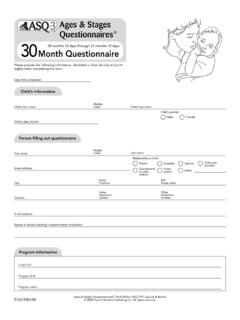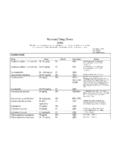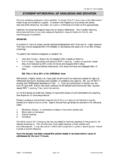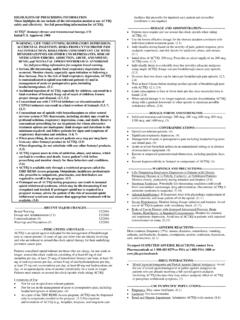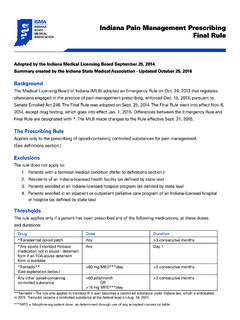Transcription of 2016 Pediatric Medication Handbook - Children's …
1 For consultations with our surgeons and specialists, call(757) 668-9999 or 800-207-2022 For urgent referrals and transports to CHKD, call(757) 668-8000 or 844-480-8000 Pharmacy: (757) 668-7163 Pediatric Clinical Pharmacist On-call: (757) 456-6180 NICU Clinical Pharmacist On-call:(757) 475-57242016 Pediatric Medication Handbook12 INDEXWhen referring a child, please have the following information available: Name, age, weight, date of birth Vital signs including blood pressure, heart rate, respiratory rate, temperature, and oxygen saturations Pertinent history and physical findings: general appearance ( , degree of distress), capillary refill, quality of pulses, breath sounds, and level of consciousness Lab and X-ray data, if available IV access - site and type Therapies administeredTABLE OF CONTENTSCHKD Emergency Medicine/Critical Care Medications and Dosing Guide.
2 2 CHKD Pediatric Medications and Dosing Guide ..9 CHKD Hematology-Oncology Medications and Dosing Guide ..26 Pharmacologic Management of Anxiety and/or Violent/Aggressive Behavior of Pediatric Patients ..36 CHKD Neonatal Medications and Dosing Guide ..38 CHKD Pediatric Pain Management Reference Card ..52 Index ..60 Care has been taken to confirm the accuracy of the information in this Handbook at the time of publication. However, the nature of drug information is that it is constantly changing because of ongoing research and clinical experience and is often subject to interpretation. Thus, the reader is advised that the authors, and children s Hospital of The King s Daughters, cannot be held responsible for new information or for any errors or omissions in this Handbook or from any consequences arising from them.
3 Because of the brevity of this Handbook , readers are encouraged to consult other references (eg, Lexi-Comp ) for complete drug information. Also, the reader is advised that decisions regarding drug therapy must be based on the individual patient s clinical status, the judgment of the clinician, changing information about a drug, and changing medical practice. Information in this Handbook is initial dose recommendations and guidelines INTUBATION Estimated ETT SIZE = 4 + (pt s age in yrs) 4 Cuffed ETT tube = + (pt s age in yrs) (for age 2 or older) 4 ETT position at lip (in cm) estimated as 3 times ETT diameter (in mm). For example, mm ETT should be cm at the lip. INITIAL VENTILATOR SETTINGS (volume mode; TV = tidal volume) TV = 6 - 10 mL/kg PEEP = 5 cm H2O FiO2 = Or 40% (Adjust to keep O2 sat > 90% IMV = 15/min for child and 20 - 30/min for infants PIP less than 35 cm H2O Inspiratory time = - sec infant; - sec child; - 1 sec adolescent HYPOVOLEMIC/SEPTIC SHOCK: 20 mL/kg as rapid bolus of an isotonic, non-glucose containing solution ( , lactated ringers or normal saline).)
4 Repeat bolus PRN based on distal pulses, blood pressure, and capillary refill. There is no maximum; the amount given is determined by the needs of the patient. Consider colloid ( , 5% albumin) after 40 - 60 mL/kg of crystalloid if shock persists. MINIMAL BLOOD PRESSURE VALUES 0 to 1 month Systolic pressure > 60 mmHg 1 month to 1 year Systolic pressure > 70 mmHg Greater than 1 year Systolic pressure > 70 mmHg + 2x (age in years) 10 years Systolic pressure > 90 mmHgCHKD Emergency Medicine / Critical Care Medications and Dosing GuidelinesEmergency Medicine Clinical Pharmacists phone: 8-5456 PICU Clinical Pharmacist phone: 8-8034 CARDIOVERSION/DEFIBRILLATION(use lower energy dose initially and increase if needed) Atrial - 1 joules/kg; synchronizedVentricular Tachycardia with - 2 joules/kg.
5 SynchronizedVentricular Fibrillation or Pulseless Ventricular Tachycardia2 - 4 joules/kg Emergency GuideRESUSCITATION MEDICATIONSA miodarone5 mg/kg IV/IO (Max dose 300 mg) bolus for VF / pulseless VTor infuse over 20 - 60 min for a perfusing mg/kg IV; use mg/kg IM/ET IV, Max: 1 mg IVBicarbonate1 mEq/kg IVCalciumCa Chloride 20 mg/kg = mL/kg of 10% solutionMax:1000 mg/doseCa Gluconate 60 - 100 mg/kg = - 1 mL/kg of 10% solution via slow IV pushMax: 2000 mg - 1 gm/kg IV (2 - 4 mL/kg D25%) mg/kg IV/IO ( mL/kg 1:10,000)Max: 1 mg/dose (10 mL 1:10,000)Max ET: mg/doseLidocaine1 mg/kg bolus - 1 unit/kg bolus IV/IO in epinephrine-refractory cardiac arrest (not routinely recommended) Adult (> 40 kg): 40 unitsCARDIOVASCULAR INFUSIONSA lprostadil (Prostaglandin E1) - mcg/kg/minDopamine2 - 20 mcg/kg/minDobutamine2 - 20 mcg/ - 1 mcg/kg/minEsmololLoad: 300 - 500 mcg/kg over 15 min;Infusion: 50 - 250 mcg/ - 1 mg/kg/hr.
6 Max = 3 mg/kg/hrMilrinoneMay load with 25 - 50 mcg/kg over 30 - 60 min (check with attending)Infusion: - 1 mcg/ - 5 mcg/kg/min; Prefer CVL administration to reduce volume - 2 mcg/kg/minNitroprusside (Nipride ) - 5 mcg/kg/min;Adult ( 40 kg) initial infusion: mcg/ - 3 mcg/kg/min;Adult ( 40 kg) initial infusion:10 mcg/min(Note that dose is not weight-based in adults).Commonly used maximum dose of 200 mcg/minVasopressinSHOCK DOSING - units/kg/hr; titrate based on ( 40 kg): - units/min (Note that dose is not weight-based in adults)54 INDEXHEPARIN DOSING AND DOSE ADJUSTMENTSH eparinIV as a Continuous infusionLoading dose: 75 units/kg IV bolus over 10 minutes Maintenance dose heparin (100units/mL) < 1yo: 28 units/kg/hr> 1yo: 20 units/kg/hrAdult: 18 units/kg/hrFor obese patients (BMI> 30) use ideal body weight + 40% of (actual body weight-ideal body weight).
7 Dosing weight= IBW + (ABW - IBW) Example: For a 140 kg patient with an ideal body weight of 70 weight= 70 + (140 - 70) Calculated dosing weight= 98 kgHeparin Dose Adjustments for Patients < 18 years of ageDose adjustments and re-peat assessments based on PTT for patients < 18 years on heparin therapy: PTT Bolus units/kg Hold (min)Rate change, % Repeat PTT < 50 50 0 +10 4h 50 - 59 0 0 +10 4h 60 - 85 0 0 0 Next day if in this range 2 consecutive times 86 - 95 0 0 - 10 4h 96 - 120 0 30 - 10 4h > 120 0 60 - 15 4h Heparin Dose Adjustments for Patients 18 years of ageDose adjustments and re-peat assessments based on PTT for patients 18 years on heparin therapy: PTT Bolus units/kg Hold (min)Rate change, % Repeat PTT < 50 80 0 +15 4h 50 - 59 0 0 +15 4h 60 - 85 0 0 0 Next day if in this range 2 consecutive times 86 - 95 0 0 - 10 4h 96 - 120 0 30 - 10 4h > 120 0 60 - 20 4h ACUTE ALLERGIC REACTIONSE pinephrine (1:1000) mg/kg/dose IM (Max: mg/dose)Diphenhydramine (Benadryl ) 1 mg/kg/dose IV (Max: 50 mg/dose)Methylprednisolone(Solumedrol )2 mg/kg/dose IV (Max: 60 mg/dose) mg/kg (Max first dose = 6 mg) rapid IVP.
8 May double dose up to 12 mg/dose and repeat in 1 - 2 min**Contraindicated in heart failure patientsAmiodaroneLoad: 5 mg/kg IV over 25 min, may repeat x 2 Infusion: - 15 mcg/kg/min (usual initial goal 5,000 mcg/kg/day)Adult initial infusion: 1050 mg over 24 hours then mg/minuteINTUBATED PATIENT SEDATION/PAIN PROTOCOLFor sedation start with lorazepam or midazolam; for pain start with fentanyl or morphineDexmedetomidine (Precedex )Initial: - mcg/kg/hrMax: 2 mcg/kg/hrFentanylInitial: 1 - 2 mcg/kg/hrMax: 10 mcg/kg/hr (if in the PICU setting)Lorazepam (Ativan )Initial: mg/kg/dose IV/PO every 6 hrs. If transitioning to lorazepam to wean off other benzodiazepines, larger doses may be needed - discuss with : mg/kg/dose IV/PO every 6 hrs. If transitioning to methadone to wean off other opioids, larger doses may be needed - discuss with (Versed )Initial: mg/kg/hr.
9 May consider loading dose of - mg/kg. In Adults ( 50 kg) an initial infusion of - mg/kg/hr is recommended. Max: mg/kg/hr MorphineInitial: 10 - 20 mcg/kg/hrMax: 150 mcg/kg/hrKetamineInitial: - mg/kg/hrMax: 2 mg/kg/hrPropofol50 - 200 mcg/kg/minUse in PICU limited to 48 hours by continuous infusion76 INDEXMISCELLANEOUS MEDICATIONSA lbumin 4 mL/kg (1 gm/kg) of 25% solution; round to vial size if fluid resuscitation, infuse 10 - 20 mL/kg of 5% albumin IV/IO rapid (Mucomyst )Mucolytic: 2 - 4 mL of 10% or 1 - 2 mL of 20% along with albuterol, given with each episode of CPT for 24 hoursDexamethasone(Decadron )Extubation or upper airway swelling: - mg/kg/dose IV every 6 hrs Max:8 mg/doseMannitol (20% or 25%)Herniation/emergent ICP management: 1 gm/kg/dose IV over 20 - 30 minutes ICP management: - gm/kg/dose every 6 hours for serum osmolarity < 320 Sodium chloride 3% (Hypertonic soln = 513 mEq Na/L)Use in the ICU or ED setting onlyBolus: Infuse 4 - 6 mL/kg over 15 - 30 mins (delivers ~2 - 3 mEq/kg of Na)Continuous infusion.
10 - 1 mL/kg/hourTHAM (Tromethamine)3 - 4 mL/kg/dose IV (~1 mmol/kg/dose)VasopressinDiabetes Insipidus:Begin infusion at units/kg/hr - double infusion rate every 5 - 10 min until UOP< 2 mL/ - 1 mg/kg/dose IV; lasts 15 - 45 min; fastestonset of nondepolarizing agentsInitial infusion: 7 - 10 mcg/ - mg/kg/dose IV; lasts 20 - 40 minInitial infusion: mg/ - 5 mcg/kg/dose PO every 8 hrs in addition to opioid and/or benzodiazepineDexmedetomidine (Precedex )ED sedation protocol: a loading dose of 2 mcg/ kg IV over 10 minutes, then 2 mcg/kg/hour. May repeat load up to 2 more times if (Valium )Oral - mg/kg/day PO divided every 6 hrs(Long half- life with chronic dosing; may dose BID or TID)IV - mg/kg/dose IV every 2 to 6 hrsMax: mg/kg/dayEtomidateIntubation: mg/kg/dose (Max dose 20 mg) IV once Fentanyl1 - 2 mcg/kg/dose IV every 1 hr PRNK etamine1 - 2 mg/kg/dose IV every 2 hrs PRN2 - 4 mg/kg IM for procedural sedationLorazepam(Ativan ) - mg/kg/dose IV/PO every 6 hrsMax: 6 mg/dose (PICU, ED), 2 mg/dose (Floor)Midazolam(Versed )IV mg/kg/dose IV every 1 hr PRN Max: 5 mg/doseOral - mg/kg/dose POMax: 20 mg/doseIntranasal - mg/kg/dose INTRANASALMax: 10 mg/dosePentobarbital2 - 3 mg/kg/dose IV/IM (Max.)







